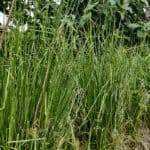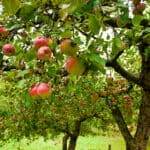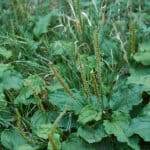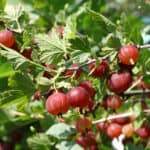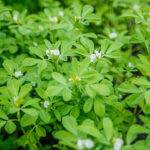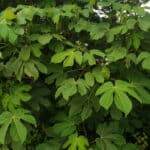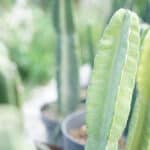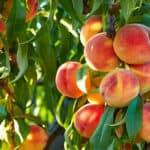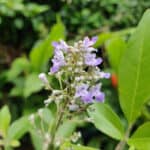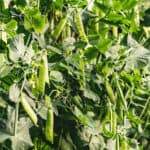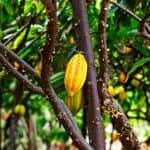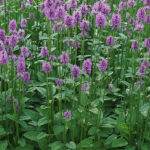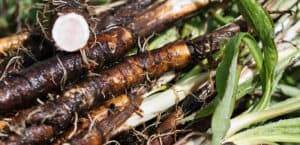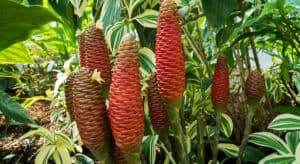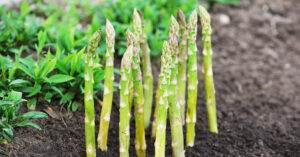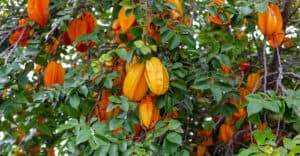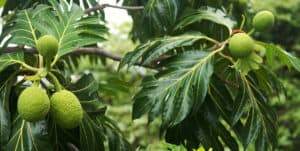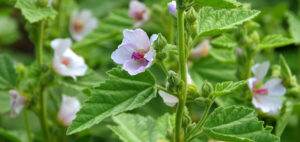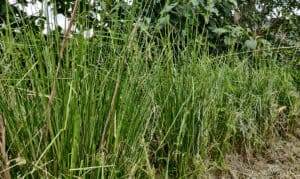With its graceful white plumes dancing on tall stalks, black cohosh is like a maiden in the forest.
Delicate and lovely, it is a beaming light in the shadows of the understory.
But it is not these beautiful blooms that hold the medicine of this sacred plant.
No; one must uncover the dark, gnarly roots beneath the soil to find its medicine.
The medicine of Black Cohosh is both mystical and practical – it holds a richness and depth that goes beyond the physical.
But, before we can dig into the uses and teachings of this plant, we must first be introduced to it.
As with any relationship, we must first uncover the history and uniqueness of the other.
Then, we’ll dive into how to grow this exquisite medicine.
Once you have everything you need to know about cultivating it in your tended landscape, I’ll share Black Cohosh’s medicinal uses, as well as my unique perspective of what this plant represents in the psyche.
Plant Overview
Black Cohosh (Acteae racemosa; previously Cimicifuga racemosa) is an herbaceous woodland perennial native to central and eastern North America.
It belongs to the Ranunculaceae or buttercup family and has several common names, including black snakeroot, bugbane, bugwort, rattleroot, and rattleweed.
These common names reveal much about Black Cohosh’s nature.
Black Snakeroot references the back, tangled roots that somewhat resemble a mass of snakes and its traditional use as a snakebite remedy, or what the Idenginous People call a ‘Snake Medicine.’
Bugbane alludes to Black Cohosh’s prominent aroma, which bugs and pests seem to dislike, making black cohosh a useful garden ally in this sense.
Bugwort is similar, but the wort signifies this plant’s use as a medicine.
Lastly, rattleroot and rattleweed point to this plant as a snakebite remedy, but these names have more to do with the dry seedheads.
The seedheads rattle when shaken, producing a sound like that of a rattlesnake (Wood, 219).
Black cohosh’s native range extends from southern Quebec and Ontario down to the mountainous regions of Georgia and Alabama and west to Arkansas and Missouri.
Its native range, once widespread, has now dwindled due to overharvesting.
It is listed as “at risk” by the United Plant Savers.
As such, it’s worthwhile for gardeners and permaculturists to cultivate this native woodland medicinal in their tended landscape.
Historical Use
As a North American native plant, Black Cohosh was (and is still) used by Indigenous people.
Its native Algonquin name, squaw root, reveals its traditional use as a female tonic.
It was used for menopausal symptoms such as hot flashes, menstrual problems such as dysmenorrhea (painful menses), amenorrhea (lack of menses), and as a parturient to induce labor.
Black Cohosh was also used for conditions such as inflammation, coughs, musculoskeletal aches and pains, rheumatism, arthritis, and diarrhea.
Black Cohosh is still used for most of these historic uses today.
Early colonial settlers learned of Black Cohosh uses from the Native Americans and sent it back to Europe where it was (and is) recognized as a valuable medicine.
It grew in popularity, and between 1820 and 1926, it was listed as an official drug of the US Pharmacopoeia.
Many eclectic physicians favored it for its powerful medicinal effect on the musculoskeletal system.
Black Cohosh Identification
Black Cohosh’s base and stem leaves are smooth and compound, sometimes three times divided, and grow alternately along the stem.
One leaf can have up to 20-70 toothed leaflets, each 1-4 inches long.
The end leaflet, or terminal leaflet, is usually three-lobed.
The light green stems and petioles are light green, smooth (nearly so), and purple at the branching points.
They are covered with a fine layer of waxy hairs.
Black Cohosh sends out its impressive flowering stalk between June and September, which can reach 5-8 feet in height.
The beautiful, maiden-like inflorescence is botanically known as a raceme, which denotes an elongated flowering stalk that has individual flowers arising from their own stalks.
Black Cohosh’s distinguishing raceme is the reason for its species name, racemosa.
Black Cohosh flowers are about ½ inch across and lack petals; they are made up of several showy white stamens.
The buds have 4-5 small sepals that drop when the flowers open.
As the seedhead matures, it turns dark brown with papery follicles that hold the seeds.
As these follicles age, they split open, allowing the seeds to fall to the ground if the seed head is disturbed by humans, animals, or the elements.
The most distinguishing characteristic of Black Cohosh is its long and slender flowering stalk.
In fact, it is quite difficult to identify Black Cohosh in its vegetative state.
It closely resembles red baneberry (Actaea rubra) and white baneberry or doll’s eye (Actaea pachypoda), among many others.
All that to say, it’s better to cultivate Black Cohosh than it is to harvest in the wild due to it being an “at-risk” herb.
Growth and Care
Black Cohosh grows in zones 3-8 and prefers full shade to part shade.
It does seem to bloom more consistently in part shade rather than in full shade.
Black Cohosh prefers rich, moist soil high in organic matter or hummus and a pH of 5-6.
Because it’s a native woodland medicinal that grows in open hardwood forests, you want to think about the soil of a forest: soil that is rich in organic matter from leaf litter and decaying herbaceous plants.
Considering this, it’s best to plant your Black Cohosh in an open woodland area (if you have it).
If not, you’ll want to put it where it will receive partial shade, preferably full sun in the morning and shade in the afternoon.
You can also grow it in a well-watered pot with artificial shade (such as a sheet overhead) if you live in a semi-arid climate.
Wherever you plant Black Cohosh, ensure that you amend the soil generously with compost and organic matter.
Propagation
Black Cohosh can grow from seed or root division, though it’s easier to grow it from root division.
Divisions can be gathered from mature plants in the fall after they have set seed or in the early spring when new shoots are just emerging out of the soil.
When dividing the roots, you’ll want to ensure that each root division has at least one bud and about 1-2 inches of rhizome and rootlets.
Plant it in the ground or a pot the same way it was previously growing; the same soil depth with the bud pointing upwards and the rootlets splayed out and pointing down.
When growing Black Cohosh from root division, it will take about three to five years for it to reach maturity and harvestable proportions.
The larger the division, the sooner you’ll be able to harvest (Blankespoor, Chestnut School of Herbal Medicine).
Starting Black Cohosh from seed is a little trickier, as it requires one month of warm/moist stratification, three months of cold/moist stratification, and then another two to three months of warm/moist stratification.
In essence, you must mimic the natural germination cycle Black Cohosh has in the forest.
It drops its seeds early to mid-fall when the temperatures are still warm, then they lie in the moist soil throughout the winter, and then they don’t germinate until temperatures rise again in the late spring.
You can mimic this by planting your seeds where you want them to grow or in outdoor seed trays in the fall (when it’s still relatively warm) and leaving them to do their thing.
Germination can take a while, and sometimes seedlings don’t emerge until June, so be patient with them and don’t lose hope.
Alternatively, you can use the refrigerator method, which allows you more control over the stratification process.
To use this method, combine your Black Cohosh seeds with a small amount of damp soil in a plastic sandwich bag.
Place your seeds in a warm, dark area – a drawer works perfectly.
After one month of warm/moist stratification, you’ll want to transfer your seeds to the fridge for three months of cold/moist stratification.
Check the seeds every so often to make sure the sand isn’t dry and to give them fresh air.
When you transfer to the fridge, place the bag with your seeds inside a brown sandwich bag so that it’s in a dark environment and away from the light.
Once those three months are up, you have two options: plant your seeds in a seed tray indoors with bottom heat or place your seeds in a drawer for another two months.
If you decide to plant your seeds right after the cold/moist stratification period, just know it will take about two months or so for the seeds to germinate.
Either way, when you plant the seeds, sow heavily as germination rates are poor.
If you plant into a seed tray, choose one with large and deep cells, as you’ll want your seedlings to be fairly strong and healthy before you transplant them.
Once you’re ready to transplant your seedlings, step them up into larger pots or directly where you wish them to grow.
Be mindful of the amount of sun they’ll receive when they’re young.
Established plants can tolerate part shade with full sun for a few hours, but young seedlings need mostly shade and can’t tolerate full sun.
Given this, if you want your established plants to be in a partially shady area, consider keeping your seedlings in pots for a year or more in mostly shade to give them time to mature.
Herbalist and gardener Juliet Blankespoor of the Chestnut School of Herbal Medicine recommends obtaining your seeds or root divisions from nearby areas if possible due to Black Cohosh’s wide range.
By obtaining seeds or root divisions from nearby areas, you’ll be growing Black Cohosh already adapted to your climate and soil.
For example, if you bought Black Cohosh root divisions from a hot and humid climate and your climate is more temperate, the Black Cohosh may not establish as well or as quickly.
Continued Care
Despite its somewhat complex germination requirements, Black Cohosh is one of the easiest woodland medicinals to grow.
It can reach sizable proportions if given its preferred conditions (part shade, lush soil), so you’ll want to space plants about 3-4 feet apart.
If growing Black Cohosh in a shady forest, you can plant them closer together – 2-3 feet, as they don’t grow as large in full shade.
While Black Cohosh is quite hardy once established, the seedlings and young plants require more tending.
When young, Black Cohosh can get outcompeted easily by opportunistic plants, so it’s important to keep the area around Black Cohosh free from weeds.
Pests and Diseases
The main things to watch out for with Black Cohosh are fungal root and leaf diseases.
The best ways to prevent fungal pathogens from affecting your Black Cohosh is to plant it in a polyculture (diverse habitat), place it where it receives adequate soil drainage, and ensure adequate airflow between plants.
Because Black Cohosh is a woodland perennial, it’s connected to the mycorrhizal network and beneficial bacterial organisms of the forest.
The relationship between these organisms and Black Cohosh helps prevent pathogenic bacterial and fungal diseases, so it’s best to plant black cohosh in healthy forested areas.
Alternatively, if you’re planting Black Cohosh out in the field, in the garden, or in pots, inoculate the soil with woodland soil to introduce those beneficial bacteria.
You can also mix an all-purpose mycorrhizal inoculant with your growing medium to help your Black Cohosh thrive.
Other than fungal diseases, Black Cohosh can be affected by deer, slugs, rodents, cutworms, and leaf-eating beetles (Blankespoor, Chestnut School of Herbal Medicine).
Harvesting
The roots/rhizomes are the part of Black Cohosh that you harvest for medicine.
Only harvest rhizomes from mature, healthy plants that have gone through a couple of seasons of flowering and setting seed.
Depending on how you grow Black Cohosh, whether from seed or root division, it can take three to seven years for it to reach harvestable proportions.
Black Cohosh started from root division will be ready to harvest sooner than Black Cohosh started from seed.
Furthermore, plants grown in lush, amended soil in part shade will reach maturity faster than full-shade plants.
Once your Black Cohosh is ready for harvesting, dig the roots out in the fall after the plant has set seed using a digging fork and shovel.
It’s best to replant a root division to ensure future harvests.
Immediately wash the roots, cut them, and prepare them fresh as a tincture or dry them on screens or in a dehydrator.
Juliet Blankespoor recommends cutting the rhizomes at tight junctions and using a bristle brush to help with effective cleaning.
Medicinal Uses
Parts Used: Rhizomes
Medicinal Actions:
- Alterative
- Nervine
- Bitter Tonic
- Emmenagogue
- Spasmolytic
- Anodyne
- Expectorant
- Parturient
- Emetic (high doses)
Herbal Preparations: Tincture, decoction, capsule
When walking the plant path, there are certain herbs that stand out to you.
There’s something about them that resonates with your being, and you feel inexplicably drawn to them.
These plants are often called your “plant allies.” Black Cohosh is certainly one of my most treasured plant allies.
It calls to my spirit, and through this relationship, I’ve learned much about the spiritual and physical uses of Black Cohosh.
Black Cohosh is a powerful herb that straddles the divide between medicine and poison.
That said, it is not as deadly as some of our other toxic medicinals, such as poke root (Phytolacca decandra) and foxglove (Digitalis sp.).
Rather, it’s a medicine where dosage matters, as too much of it can cause nausea, gastrointestinal discomfort, and vomiting.
This is important to note if you wish to work with this medicine, and I encourage you to start with smaller doses (1-2 ml at the most).
There are three major systems in the body that Black Cohosh influences that I wish to write of: the nervous system, the female reproductive system, and the musculoskeletal system.
Black Cohosh also influences the respiratory system as a relaxing expectorant.
Because I don’t tend to use black cohosh in that way, I won’t be diving deep into its use as an expectorant, but that shouldn’t discourage you from exploring Black Cohosh for the respiratory system if that calls to you.
The Nervous System
It’s important to start with Black Cohosh’s effects on the nervous system as its use as a nervine sedative and antispasmodic greatly influences its effects on the female reproductive and musculoskeletal systems.
As a nervine sedative, Black Cohosh relaxes and sedates the nervous system.
Through this, it calms tense nerves that are causing muscular spasms or cramps, making it an antispasmodic or spasmolytic.
Amazingly, Black Cohosh communicates this system affinity through its taste.
One of the best ways to learn about herbal medicine is to acquaint yourself with the various tastes of herbs.
Each taste tells a story, or rather; how the herb will affect the body.
Black Cohosh is predominately bitter and acrid in taste.
The bitterness tells us it will affect the digestive system by stimulating liver function and gall bladder secretions.
It also tells us it is a drying, cooling remedy as bitters tend to drain fluids.
The acrid taste is unique to herbs that strongly affect the nervous system, notably antispasmodic and hypnotic herbs.
Black Cohosh isn’t considered a hypnotic, but it is certainly one of our stronger nervine sedatives and a reliable antispasmodic remedy for the respiratory, female reproductive, and musculoskeletal systems.
The Female Reproductive System
Black cohosh uses for the female reproductive system, especially menopause, is what it is most known for and widely used for today.
It is a traditional female remedy and is quite effective for a variety of female reproductive complaints.
As an emmenagogue, Black Cohosh stimulates blood flow to the uterus, which can relieve amenorrhea (lack of menses) or dysmenorrhea (painful menses).
Along those lines, its spasmolytic properties make it a wonderful ally for periods where the blood feels stuck and stagnant, there’s congestion of fluids or swelling, and there’s associated cramping.
Its nervine sedative action helps ease tension throughout the body and the anxiety, frustration, stress, or depression that often accompanies painful periods.
It is often combined with Motherwort (Leonurus cardiaca) for this purpose.
If the womb feels cold, it can be combined with Ginger (Zingiber officinale) or Rosemary (Rosmarinus officinalis) to help warm things up.
If you examine the growth habits of the roots and how twisted and congested they are, they have much to reveal about the medicine of this herb.
To me, Black Cohosh is for the woman who has a similar sensation in her uterus during menstruation: things feel stuck, dark, and congested both physically and mentally.
I’ve found that Black Cohosh is an ally in releasing congestion in the uterus through its emmenagogue and bitter tonic effects, as well as helping to release dark, stagnant thoughts and emotions.
As mentioned earlier, Black Cohosh is commonly used to alleviate menopausal symptoms such as hot flashes, insomnia, irritability, and depression.
Several studies have been conducted on black cohosh’s efficacy in this regard.
Again, it pairs beautifully with Motherwort for menopausal issues.
Black Cohosh can relieve menopausal and menstrual complaints because it’s a hormone regulator.
While research has been unable to determine how exactly Black Cohosh balances hormones, it seems to regulate the hypothalamic-pituitary-ovarian axis.
It’s also considered a phytoSERM (SERM = selective estrogen receptor modulator), which means it affects estrogen receptor sites (Blankespoor, Chestnut School of Herbal Medicine).
To regulate hormones, Black Cohosh should be used tonically.
It should be taken in small doses for several months for both menopausal symptoms and menstrual complaints, including the symptoms listed above, as well as ovarian cysts, uterine fibroids, infertility, and irregular cycles.
That said, female reproductive complaints can be complex, so it’s important to speak with a qualified herbalist for the best remedy and holistic protocol for your specific needs.
The Musculoskeletal System
Black Cohosh is a wonderfully effective remedy in alleviating musculoskeletal complaints such as low back pain, neck and shoulder tension, arthritis, and cramping/spasms.
This is due to black cohosh’s antispasmodic properties, though; I do believe it also has a “special potency” towards the musculoskeletal system that is revealed through its long and slender flowering stalk.
Matthew Wood calls black cohosh “the whiplash remedy” as the flowering stalks “whip” in the breeze, which is a signature for its use in such conditions.
He confirms that he has used it to cure or palliate whiplash in dozens of cases (Wood, 221).
He goes on to explain and summarize the medicine of black cohosh perfectally:
“Black cohosh is a remedy for conditions in which the cerebrospinal fluid is “bunching up,” as I like to put it.
This is the core condition of the Cimicifuga problem, and all the characteristic conditions emanate from this situation.
The dark, brooding state of the mind, the neck and lower back pain, rheumatism, relief from fluid discharges, amelioration from menstruation, aggravation from their ceasation [sic] at menopause, the ripening and readying of the uterus late in pregnancy.
The dark, congested, interwoven roots beneath the ground present a signature of congestion, whether it be psychic or physical, which typifies this medicinal plant.” – Matthew Wood, The Book of Herbal Medicine
It is also effective for tension headaches that start in the neck and shoulders due to liver congestion.
Its bitterness helps stimulate liver function while simultaneously easing tense nerves and the musculature in the neck and shoulders.
I have successfully used Black Cohosh for this on several occasions.
Psycho-Spiritual-Emotional Properties
From my personal experience of working with Black Cohosh and from the teachings of other herbalists, Black Cohosh is specifically indicated for women who have suffered from sexual abuse.
In this regard, it is working on the psycho-spiritual-emotional aspects of the woman or person, which often manifest as physical complaints in the uterus.
To me, Black Cohosh holds deep and ancient wisdom, and I liken it to the three-faced goddess: the mother, maiden, and crone.
This is also represented in Black Cohosh’s physical medicine, which helps a woman in all three phases of her life and cycle.
I see the bright and beautiful dancing flowers as the maiden, the lush, lacey foliage as the mother, and the dark, gnarly roots as the crone.
In this, it is an initiatic remedy.
It is for the woman who has lost sight of her innocence, suffers from dark, brooding moods, and feels “stuck” because of her trauma.
There is congestion in the mind, body, and spirit.
Spiritually and energetically, it cares for the womb and will help to reclaim what is true.
Reminding one it is safe – it is safe to dive into the darkness, into the ‘blackness’ of fear and trauma, and through that dive, true healing can occur.
It will shoot out of the mass and entanglement of dark trauma as this vibrant, lacey flowering stalk – saying here I am!
Look how beautiful, innocent, and pure I am!
Black Cohosh is the old crone, the wise grandmother of the forest, who takes you to the darkness and believes in your strength to come out the other side pure white and vibrant.
It is the wise old crone helping you along your path, teaching you the ways of the Wild Woman.
Consciously working with the medicine of black cohosh can help untangle the dark roots of the past, move stagnant energy, and reclaim one’s innocence and femininity.
Safety and Contraindications
Because Black Cohosh is a strong emmenagogue, it should not be used during pregnancy (it is traditionally used to stimulate labor as a parturient).
High doses can cause vomiting, nausea, headache, and gastrointestinal discomfort.
It’s best to start with small doses and increase as necessary.
Experienced herbalist 7Song recommends limiting the dosage to a max of 5 mL per day.
If you are on medications, nursing, or have a history of liver problems, consult with a qualified herbalist or trusted healthcare professional before taking Black Cohosh.







